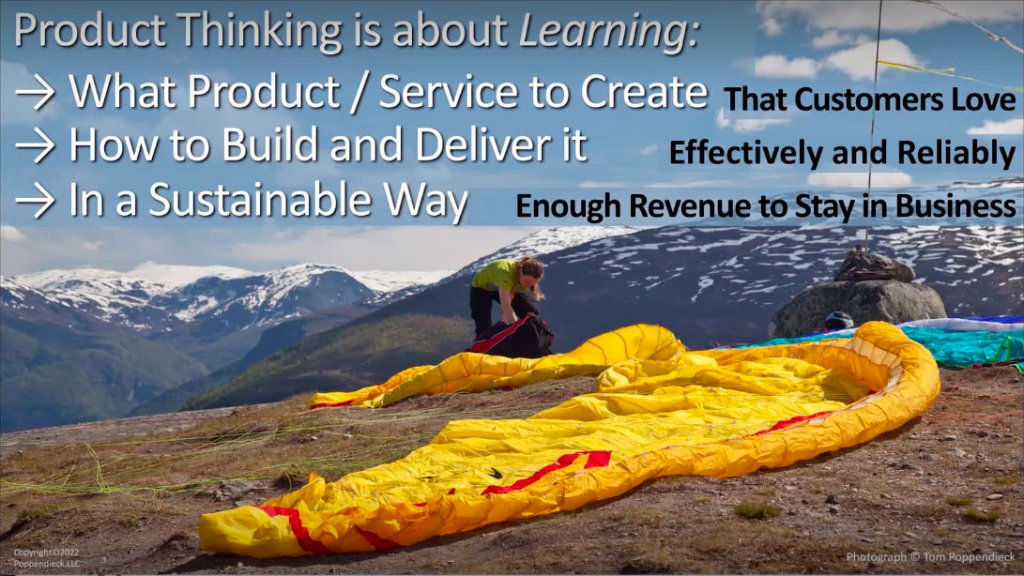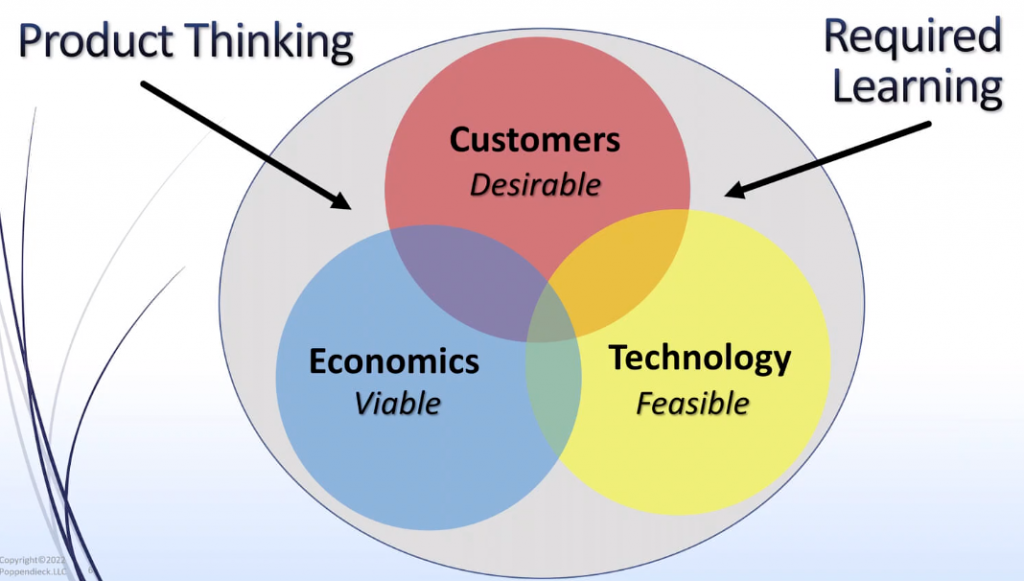The future of Agility 2/2. – Product thinking
On 22 and 23 September the first Agile Get-Together glocal Agile conference took place in Budapest and thanks to online streaming worldwide, organised by Sprint Consulting and UST. The main sponsor of the event was Morgan Stanley. The conference keynote speakers Diana Larsen, Linda Rising and Mary Poppendieck are renowned Agile experts. Their presentations foresaw the future of Agile and introduced new approaches beyond Agile. In the second half of our two-part article, we summarise the talk of Mary Poppendieck.
Mary Poppendieck revised and extended the fourth principle of the Agile Manifesto, and then pointed out the dangers of some basic Agile rules. The principle is: “Business people and developers must work together daily throughout the project”.
Product thinking
“Product thinking is about Learning.” This is how Mary Poppendieck began her presentation, immediately linking her message to Diana Larsen’s talk of the previous day on learning-based work, and the skills and techniques needed to lead such tasks. Read more about Diana’s presentation in the first part of this article.
Successful product development has three key areas, all of which require continuous learning from the organization:
1. What is the product or service that, if created, our customers will love
2. How can we create and deliver this product or service efficiently and reliably …
3. … and sustainably, i.e. in a way that generates enough revenue to sustain the business?
What is the product or service that our customers will love?
The main question leading to the creation of the right product is: why would our customers buy/use this product?
To answer this question, we need to understand
– who our customers are,
– and what is the task they want to complete.
After answering these questions, the main steps of product design are:
– Map the customer journey: map the path that the customer takes and on which they may need our product
– Establish empathy: putting ourselves in the client’s shoes, discovering what the difficulties and inconveniences might be in each step
– Find the biggest friction: Identify the biggest inconvenience removing which will give the customer the greatest possible help and value from our product. Mary stressed that identifying this point is not at all obvious.
Mary illustrated the above questions with the example of Norwegian paragliders: paragliding is incredibly enjoyable, the worst part, the biggest inconvenience, is that after landing, when the adrenaline is pumping and the only thought in the paraglidist’s mind is to immediately repeat the experience, it is an incredible hassle to pack up and get back to the top of the mountain. It is no coincidence, then, that there is a service in Norway that waits for parachutists with a minibus at the landing point and helps them get up the mountain quickly.
Figure 1.: Mary Poppendieck: Beyond Agile: Product Thinking and Software Engineering for the Future, Agile Get-Together Conference 23.09.2022.
Efficiency and sustainability
Although it was not emphasized during the presentation, it is important to underline that the word sustainability, which is also mentioned in the agile principles (“Agile processes promote sustainable development. The sponsors, developers, and users should be able to maintain a constant pace indefinitely.” ) takes on a new meaning in Product Thinking. Whereas before we focused only on sustainable speed, i.e. the appropriate technical quality and pace of work, this time Mary emphasizes the financial side of sustainability. It is a fundamental aspect, yet it can be compromised in Agile organizations if the business experts involved in product development only understands customer needs (in the figure below: customers) and not pricing and financial decisions (economics). Therefore, Mary extends the Agile principle mentioned at the beginning of this article, distinguishing between customer and economic knowledge. Together with technical knowledge (technology), three types of knowledge are therefore essential in product development teams:
Figure 2.: Mary Poppendieck: Beyond Agile: Product Thinking and Software Engineering for the Future, Agile Get-Together Conference 23.09.2022.
Agile ground-rules vs innovation
In the second half of her presentation, Mary presented a case study of the Norwegian venture builder Iterate.no. Anders Haugeto, one of the founders of the startup building company, published a blog post in September 2020, Cheating on Agile, synthesizing their experiences. Haugeto identifies three root causes that are most often responsible for the failure of startups:
– Bad timing, which usually means entering the market too early
– Dysfunctional founding team: lack of passion or diversity of opinion, and
– Weak ideas, i.e. worthless offers that fail to attract customers
He identifies agile ground rules (emphatically not practices, but rules) as the source of the above reasons, and points out that some rules that are now considered basic in Agile product development can be harmful in innovation.
Time
While agility sees fast delivery and rapid feedback as a sine qua non for success, in innovation patience and waiting are particularly valuable and may even be the most important condition for success. This waiting shouldn’t be passive, of course, but rather about monitoring the maturation of the market, customers and competitors. To refer back to the starting point of the talk: continuous learning. Short iterations can lead to premature conclusions, resulting in a quick and efficient development of the wrong product.
Teams
Although today dynamic reteaming has become part of agility, the ancient concept that team protection is essential in Agile teams, that team dynamic maturation, measurability and predictability are a prerequisite. In contrast, participants in innovation must be given the opportunity to move between teams. To find the idea, the product, the team that they can participate in with the necessary passion.
Priorities
Prioritisation is not a good practice when building startups. Instead of priorities, we need continuous brainstorming and experimentation. The worst ideas can produce the best results. Innovation therefore requires a high-level vision rather than short-term goals. While this is not a new idea; the role and importance of experimentation has been on the Agile horizon since the advent of Lean Startup, it cannot be left out from the summary of the basics of Agile innovation.
Development or innovation?
What next? Should we let go of the Agile ground rules we thought were critical, or stick to them? When to relax the framework and when not to?
The Agile community is no stranger to weakening the rules, to the need to increase the degree of freedom. Just look at the changes in the official description of Scrum. The Scrum rulebook is more permissive and general from version to version. This is partly due to the move away from IT, to extend Scrum to other industries, and partly to facilitate autonomy for advanced, successful teams. However, just as the Scrum Guide’s more permissive approach is also dangerous: it may not give enough guidance to beginner organizations and teams (Agile newbees), questioning the basic rules of Agile is both useful and dangerous. The key to success is always: finding the right approach for the organization, the product, the team. This is where a well-prepared team of consultants can help you.


